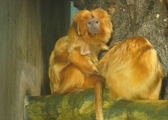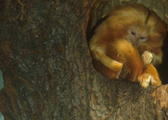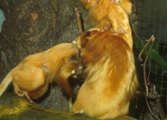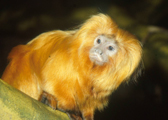



Golden Lion Tamarin




Lion tamarins have a mane derived from long hairs on the top of the head, cheeks and throat. The golden lion tamarin's color is predominantly golden with occasional orange, brown or black coloration on the tail and forepaws. It weighs about 0.5 kg (1.1 lb) and averages about 25 cm (10") in head/body length, not counting the tail.
The golden lion tamarin prefers primary lowland tropical forest from sea level to 1000 m (3300'). Golden lion tamarins are omnivorous, feeding on fruits, gum, nectar, insects, and small vertebrates. The golden lion tamarin is diurnal and predominantly arboreal. It is usually found at heights of 3 - 10 m (10 - 30') above the forest floor. It sleeps there at night in tangled vegetation or, more often, in a hole in a tree, such as an abandoned woodpecker nest.
Most golden lion tamarins live in reproductive groups that occupy stable territories. The average number of individuals/group in one study was 5.4. In the wild, groups usually consist of one breeding adult of each sex and younger animals. Golden lion tamarins are cooperative breeders: all adult members of a group help to carry and feed the offspring of the group, with the adult male commonly doing the largest share. The mother only takes the babies to nurse them.
In the 19th century, the golden lion tamarin occurred in Brazil in the coastal forests of the states of Rio de Janeiro and Espirito Santo. By the early 1980's it was known only from remnant forests in the state of Rio de Janeiro in an area of occupied habitat probably totaling considerably less than 900 sq km (350 sq mi). The wild population is currently fragmented into 17 different subpopulations in isolated forest patches throughout its small range.
Why is the Golden Lion Tamarin Endangered?
More than 90% of the original Atlantic coastal forest, which contains the golden lion tamarin's habitat, has been lost or fragmented to obtain lumber and charcoal and to clear out areas for plantations, cattle pasture, and development. Capture for zoos and private collections also contributed to its decline in the past. The golden lion tamarin is still under severe threat from continued deforestation, much of which is undertaken to create weekend beach properties. Less than 2% of the forest remains in the region where the golden lion tamarin lives.
Recently, predation became a serious problem in some
areas. Golden lion tamarins in the Poco das Antas Reserve have always
been taken by predators such as hawks, owls, boa constrictors and small
cats. In most cases, the golden lion tamarin group loses 1 or 2
individuals. However, in the late 1990's, a predator learned how
to get into a tamarin group's tree den at night and kill a number of
members of the group, or even the entire group. For a while the
identity of the predator was not known. It is now believed that it may
be the tayra (Eira
barbara) - a small weasel-type of animal - that has learned to dig tamarins
out of their nest holes where they rest at night. (Franklin & Dietz 2001, Natl. Zoo 2004a, WWF 2004)
(Taken from http://www.animalinfo.org/species/primate/leonrosa.htm)
Lets Learn More About Our Little Friend, the Golden Lion Tamarian